
The Power Of Pink: How The Barbie Movie Generated A Worldwide Craze, 1 Billion Dollars + Over 100 Brand Partnerships
Aug 11, 2023How iconic does a brand have to be to advertise with just one color and no words?
If you've been anywhere with an internet connection lately, you've seen posts about the Barbie® movie. People are going to theaters; brands are showcasing their newest Barbie® pink product + even a Barbie-themed Air BnB is getting attention in California.
The "Barbie® craze" has taken over the globe - and the question is...why?
Why has Barbie® catapulted into international stardom, grabbed the heart of my barista, and had publications chasing me all week wanting thoughts on the power of color psychology in the film?
We're going to break it down step by step - incorporating the history of the brand, the movie production itself, and the marketing budget that any studio would lose consciousness over.
The History Of Barbie
To understand the impact of a color on culture, it has to be studied throughout history. Since Barbie® didn't start with ties to pink, I had to dig into the history of the brand to see when the change happened and why.
If you study Barbie® throughout its decades of success, the evolution is pretty stunning.
The toy she was invented from was actually a gag gift for men! Mattel® bought the rights to her and renamed her.
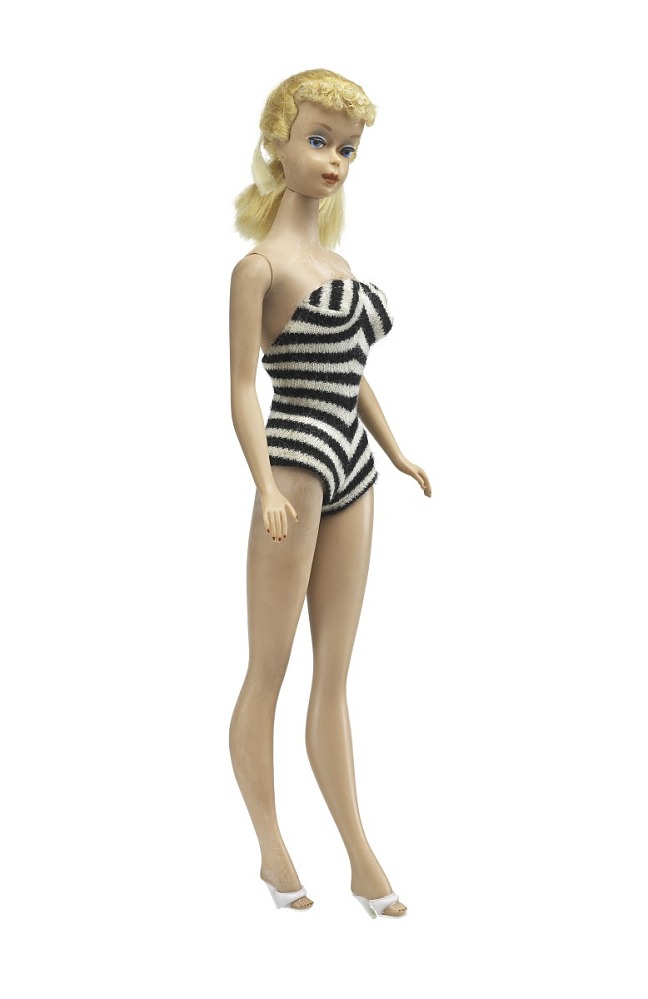
© National Museum Of American History
Barbie, originally named Barbara Millicent Roberts, launched at the American Toy Fair in New York City on March 9, 1959. She was built in tribute to iconic women at the time - like Elizabeth Taylor and Marilyn Monroe. In the first year, over 300,000 dolls were sold for $3.00 apiece.
"When Barbie® launched in 1959," Kim Culmone (Mattel’s senior vice president and global head of Barbie® and fashion dolls design) told E! in an interview, "she wasn't wearing pink. She was wearing a black-and-white striped bathing suit. She had a gorgeous red lip, gold hoops, and those great black slide mules."
Despite her unrealistic dimensions, every single woman remembers Barbie. We remember playing with her in our homes, taking her everywhere we went, and playing dress up. It led us to try on our mom's heels, put makeup on and wear beautiful dresses. In a lot of ways, it was a key staple of girls thinking of themselves as women.
All of that from a toy - pretty unbelievable, right?
“Most importantly it’s, for us, it’s really a symbolism of empowerment. Barbie® is the original girl empowerment brand,” Culmone said.
As she expanded her resume, Barbie has had over 250 careers - including landing on the moon four years before Neil Armstrong. She also ran for President in 1992 - two decades before Hillary did.
I'm showing you the history because it's crucial for you to understand how Barbie® turned from a toy into a cultural phenomenon.
Color usually always starts this way - as a movement tied to a specific novelty.
Pink was introduced to the Barbie® brand in 1972 and by 1976 was in full force: everything from clothes, accessories, packaging, fonts, and logo became their "signature pink."
Interestingly, the Barbie® logo was always pink. It evolved slightly over the years, so I'm guessing that's why they finally injected it into the packaging to see how females would respond. Obviously, it's the best decision they could have made!
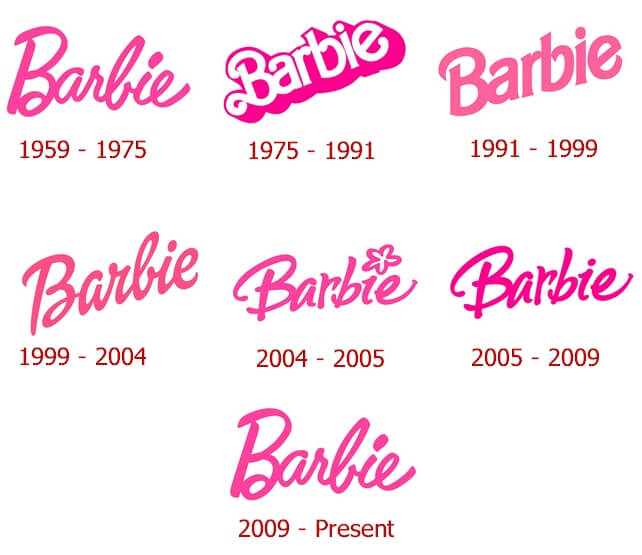
The color changed slightly over the decades, but the most agreed-upon hex code is E0218A.
You can see the color of the logo has been many varieties of pink. I would say their color is currently hot pink, but they say magenta. I'm pretty sure it's because they want to tie in with the boldness and revolution of the color - especially since the movie was released the same year Pantone® named a red-based magenta color of the year!
Culmone states: "It's not a quiet or shy pink. It's strong; it's powerful."

Pantone® partnered with Barbie®, releasing a doll in its signature pink in 2011 with the color DA1984.
What's interesting is that Mattel® has long since tried to trademark its signature color with the US Patent and Trademark Office, with no success. They also unsuccessfully sued Aqua for its song "Barbie Girl." Mattel® claimed that they were misappropriating Barbie® packaging, trade dress, and color scheme.
The court not once, but twice, sided with MCA records, saying that Mattel® "cannot show that its use of the color pink has acquired secondary meaning'. Source.
Which begs the question: can you really trademark something that has become a staple of society and inspired cultural references, reflections, and creations?
I believe all of this contributed to the creation of the movie and Mattel® being willing to work with the studio.
They wanted to finally be a part of a cultural phenomenon outside of their brand instead of watching it happen without their input and lack of control. Makes sense!
Let's look at the sales of Barbie® up until this year to see what the patterns have been.
According to Statistica, Barbie® sales were stable at 1.275 billion in 2012, dipping slowly to 905.9 million in 2015 and steadily rising again to 1.679 billion in 2021.
The pandemic actually boosted sales for the company which I found very interesting.
It's estimated that dolls and stuffed toys will generate an estimated 55.7 billion worldwide this year - with the biggest markets being China, India, and the United States. But we won't see how much of that is Barbie® revenue until the stats come out.
I'm assuming about a 25% increase, but that may be conservative!
The Barbie Movie

© Warner Bros. Pictures
The movie cost over 145 million dollars to make. For context, that's just as much if not more, than the biggest Marvel® movies.
I've seen some of the biggest action movies in Hollywood get made - thanks to my Dad working with John Woo in the 1990s and early 2000s. Seeing the storyboards, budgeting, producing...actually making the movie happen.
To see the production budget so high really surprised me - and an equal marketing budget surprised me even more!
Now, once you see the movie, it's easy to see why.
The production design is truly incredible - and insane attention to detail was given to make this a surreal and thrilling adventure for both kids and adults.
As Margot Robbie states: "Everything is fake, but everything is beautiful."
First of all, I don't think I've ever walked into a movie theatre knowing which people were seeing a film just because of the color they were wearing.
But here we were: myself and my reluctant but dedicated husband going to the local theatre at 11:10 am on a Friday. The theatre was about halfway filled with people wearing pink, ready to see the movie. A row of teenage girls in front of me in sequin pink skirts, headbands, and dresses. Two middle-aged women - one with a pink top and the other with her pink handbag in solidarity.
People were actually bonding over a female movie experience, like Sex & The City The Movie, and yet even more seemingly bonded due to the color worn. Kind of like Harry Potter where moviegoers would wear robes.
This is why I was so excited to study this phenomenon. It's not just a brand. It's not just a movie. It's not just a cultural phenomenon. But it IS all tied together due to color. One color: pink.
Think Pink is thinking of Barbie®, and vice versa.
Let's break down the film.
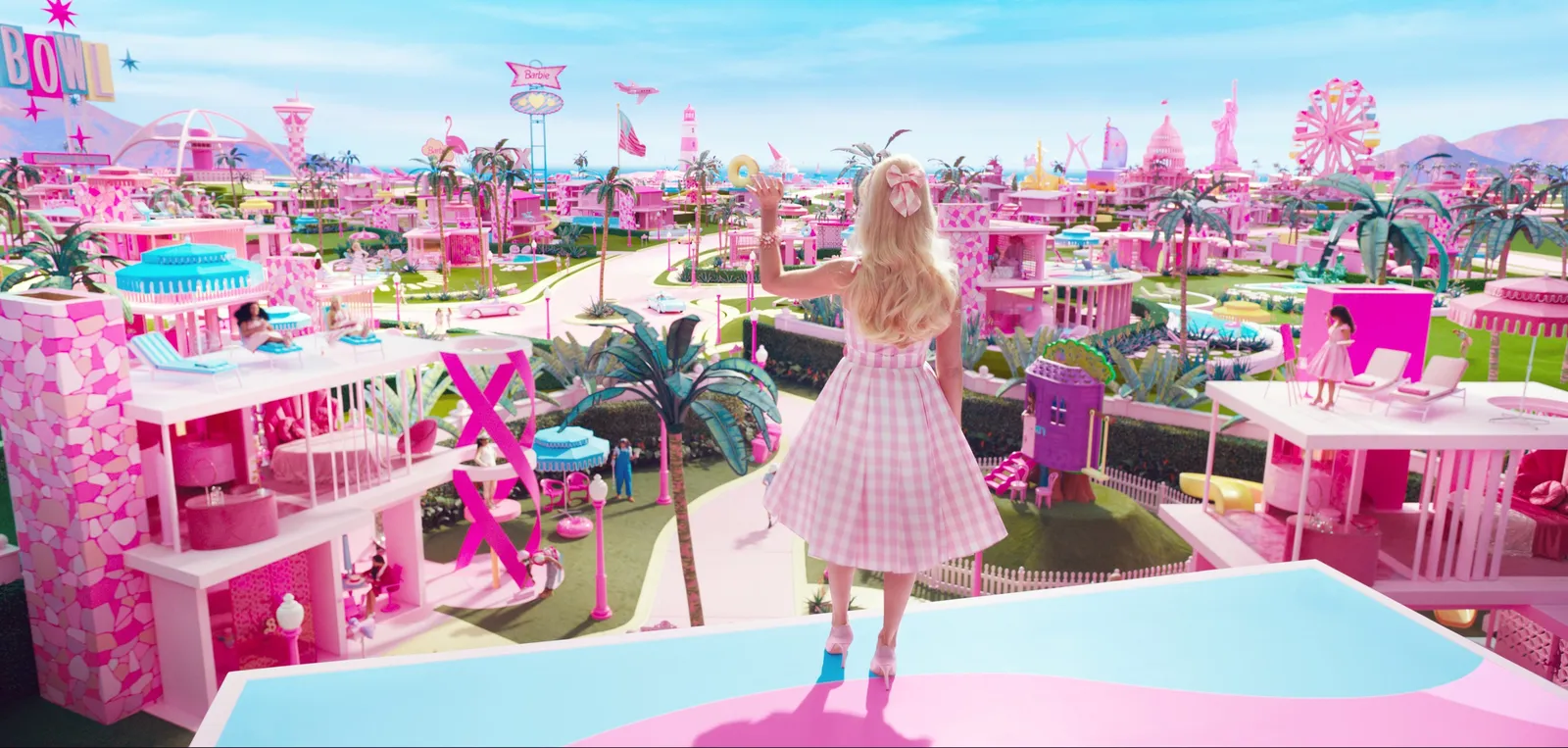
© Warner Bros. Pictures / Courtesy Everett Collection
Not surprisingly, Barbieland® is filled with all pastel colors. If you've know about color analysis, this would be within the traditional "spring" palette. That means every color has a white undertone - giving it that spring feeling. Very light, bright, happy, and young.
Having seen some detailed explanations of the production design, even the "white" in scenes was technically the lightest tint of pink, causing a worldwide shortage of pink paint to support the production design. In response to Barbie®, paint creator Stewart Semple created “the Barbiest pink.” Called “Pinkie,” anyone can buy the paint color — as long as they make it clear they are not employed by Mattel®.
Jocelyn Silver from Vogue describes production designer Sarah Greenwood and set decorator Katie Spencer as blending the worlds of Mattel®, midcentury Palm Springs, and Old Hollywood to create the pink paradise. The director, Greta Gerwig, dubbed Barbieland® "authentic artificiality." (There was also zero CGI in its creation or final product.)
The three creators also had strict rules: No black, no white, and no chrome allowed.
I'm going to step back with you for a second. Coming into this film as a student of color, I have seen pink used in movies many times, and it is usually always tied to a few things.
Artificiality, latent evil, abused innocence, and even violation. So I was optimistically thinking that maybe pink could be used to mean something very different in the Barbie® movie.
It was clear that in this world, there were four primary colors. But instead of them being red, blue, green, and yellow like ours, this world consisted of pink, blue, green, and yellow.
The absence of red would symbolize the removal of aggression, increased heart rate, fear, anger, and even the ability to act and make decisions. All of which was very true when it came to the world of Barbie®.
Mainly, Barbie wears pink at the beginning of the film. She is popular, happy, in her favorite routine, and enjoying another perfect day.
She drives her pink car, waving at all the other Barbie's, and ends her day with a huge party at her place. Her outfit changes to silver sequins.

© Warner Bros. Pictures
She blurts out in the middle of the dance floor, "does anyone ever think about dying?" as Barbieland® comes to a screeching halt.
As Ken tries to say goodnight, the lighting turns blue as she turns him down once again from the romance he so desperately wants.
Blue is the color of the mind. It symbolizes intellect, deep thinking, and stepping back from the moment to reflect.
She wakes up from her first nightmare, showers in suddenly cold water, and retrieves burnt toast in a new outfit of the day - which is off-white with touches of blue.
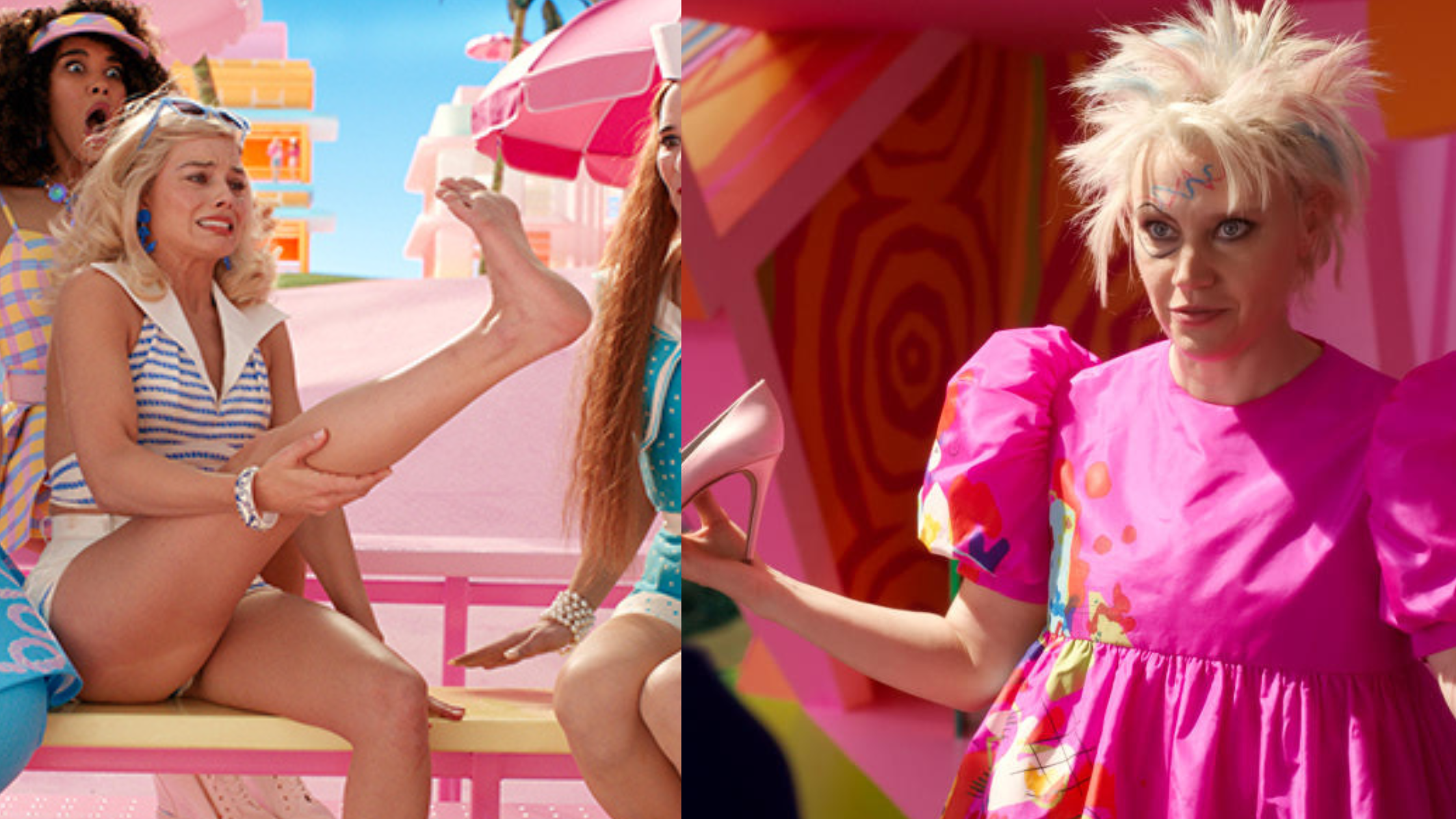
© Warner Bros. Pictures
Her feet go flat, she panics and heads up to Weird Barbie's place to try to find an answer.
Knocking on the house in a new cobalt blue dress, she meets Weird Barbie, who is entirely dressed in magenta.
Remember, magenta is all about boldness, revolution, acting differently...and we haven't seen the color in Barbieland® before.
On Weird Barbie's map, we see a sketch of a human in a blue dress. The map of Earth is also blue.
As Barbie and Ken traverse the portal to the "real world," everything is filled with the oncoming reality of blue. Blue seas, blue space, blue sky, blue mountains.
Their first outfit change keeps Barbie in hot pink, but Ken suddenly dresses in black and white.
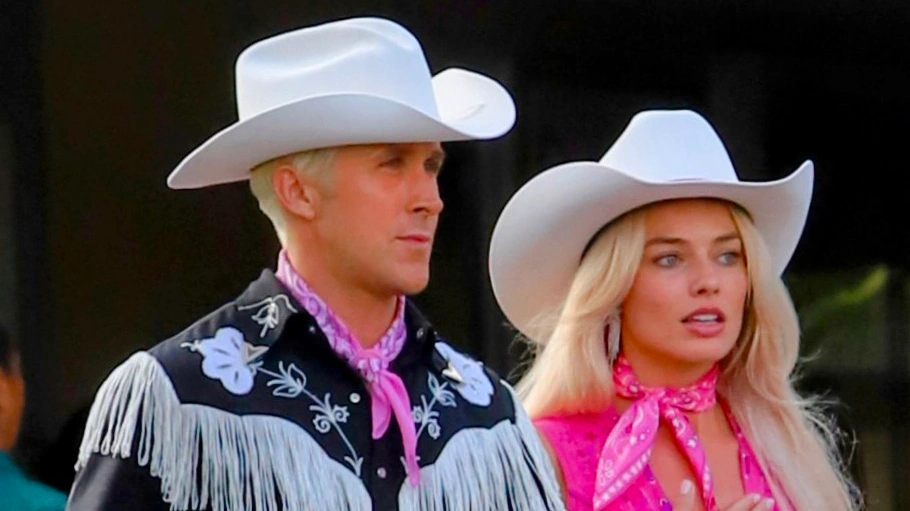
© Warner Bros. Pictures
The cubicles of Mattel® are blue, and all employees are dressed in blue.
The hallways are black and white. Obviously, the real world is black and white. No fun, no play, no femininity.
As she runs from Mattel® trying to escape, I couldn't help thinking, "Why on earth is the CEO wearing a pink tie?".
Ruth, the founder of Barbie®, is dressed in blue with a yellow jacket. Her kitchen is yellow and lit with yellow light.
Our human heroine, Gloria's car, is blue.
It's extremely clear that the people in the real world are represented by the "reality" of blue, and the "fantasy" world of Barbieland® is known by its pink.
As Gloria, her daughter, and Barbie head back to Barbieland®, she is dressed again in blue with Gloria now in pink.
We find Barbieland® in chaos as Ken is dressed again in black and white. All of the ugly colors are suddenly there - browns, blacks, whites, grays and chromes.
As Gloria restores each Barbie's memories, most transition to wearing blue or red. And when they are finally ready to take back their home, they are again all in pink.
They distract the Ken's, where the entire scene turns blue. The Ken's turn on each other, and they transition to being dressed all in black with a blue and pink floor.
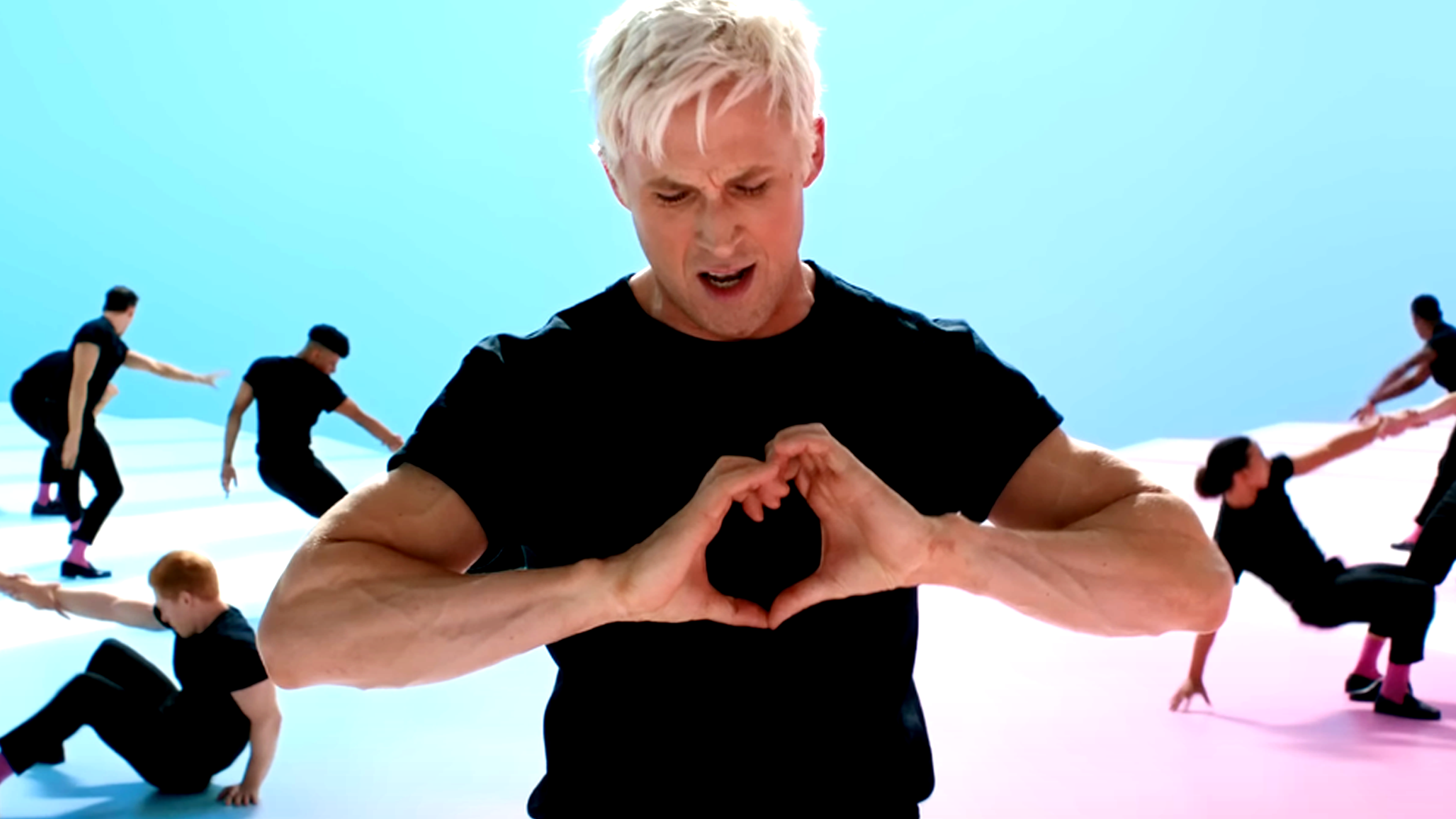
© Warner Bros. Pictures
Barbie emerges after the conflict dressed entirely in yellow.
Yellow is the contrary color. It usually means that something has two sides or that a character is feeling pulled in two directions.
She sits on her now-blue bed to tell the black-and-white-dressed Ken to try to find himself.
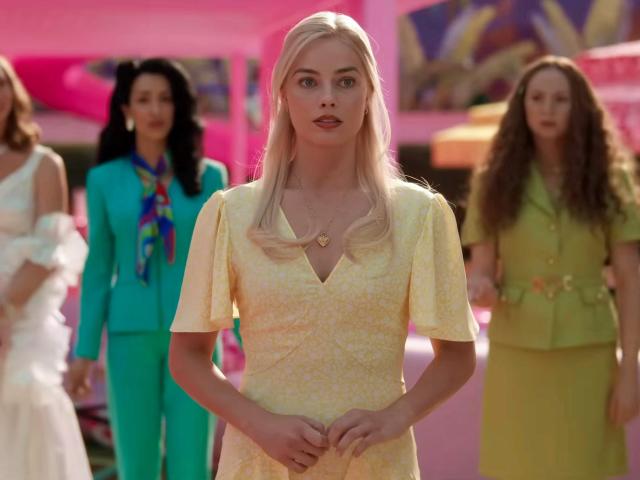
© Warner Bros. Pictures
Ruth, the creator, appears again entirely in a strong, cobalt blue while Ken waves goodbye in a pink, blue, and yellow sweatshirt.
Barbie becomes human, wearing an (ugly) brown blazer but with a pink purse and Birkenstocks to face the real world.
I'm breaking down these exact scenes for you because it's important to log how color moves through a movie.
We were able to easily see that Barbieland® was a place of joy, play, and creativity. But it was also repetitive, fake, and without individuality.
The real world, on the other hand, was cold, dark, and without feeling. But it was real and invoked true emotions.
Blue, pink, black, and white helped us psychologically understand the differences - so that when yellow came into play at the end, we could deeply understand Barbie's conflict of wanting to become real without losing her joy.
Barbie's Marketing Strategy
We've seen Barbie's history, and we've analyzed the movie...but we haven't yet looked at the marketing efforts by Warner Brothers® to make the movie a hit.
First, let's look at the sales.
So far, it has surpassed 1 billion dollars and is on track to be the highest-grossing film of the year. But how did it get there?
The marketing of the Barbie movie, in my opinion, was so incredibly successful because it was tactile.
Partnering with over 100 brands, Barbie® became as tactile as its doll - but in real world advertising.
You could rent the Barbie Dreamhouse in Malibu, CA.
You could buy a Barbie gaming console.
My old co-worker on Pretty Little Liars Shay Mitchell even partnered to create Barbie pink suitcases!
© Beis
Primark, Smash + Tess, Alex + Ani, Cotton On, Burger King, JoyBird, Crocs, Pinkberry, Gap, NYX Cosmetics, Ruggable, Impala Skate...the list goes on and on.
The movie was all about Barbie in the real world, and the marketing department made the genius move to bring Barbie® into our real world, with Mattel® leading the charge.
Suddenly, Gloria isn't the only one getting to go to Barbieland®; we are too!
Not only is there excitement and joy at the new experiences, but all of us who grew up with Barbie® are nostalgic and loving it!
And we're including our mothers, daughters, aunts, nieces, and friends...our fathers, brothers, nephews, and sons might love it too, so we bring them in as well.
Every movie has movie posters, right? Normally, there's a pretty standard formula for creating one - but this was different too.
It was just a color. PINK.

Can you remember a time when you knew instantly what movie was coming out just by one color on a poster? Me neither.
A symbol, sure. Like a wand or a slipper, but not a color.
Josh Goldstine, Warner Brothers President of Global Marketing stated that the first "electric" moment of the marketing campaign was at CinemaCon in 2022, when they released a single image of Margot Robbie, as Barbie, laughing in a pink Corvette.
"It was one of those moments that took on a life of its own," Mr Goldstine told Variety.

Then a filter came out where anyone could be on the Barbie movie poster. Celebrities worldwide jumped in on the craze - generating photos of themselves as "Barbies" for the world to see.

Dee Madigan, creative director of Campaign Edge, talked of the risk: "There's a real risk to some of that organic stuff because if the movie had been a bomb or people hated the marketing, people could use those assets to create bad memes...you lose control of the brand a bit."
But remember, Mattel® already had seen those issues play out. They probably felt like they had nothing to lose - and even if there was public hate, the controversy, and polarization might actually help boost the brand even more. Plus, the brand already had such a large amount of allegiance, loyalists would defend it to the death.
Using pink made fans build even more allegiance to the brand. And it stayed top-of-mind because brand partners kept releasing new Barbie® pink products.
Remember, according to Statistica, color increases brand recognition by up to 80%!
Mr. Newspaper, an extremely popular color analysis filter creator on TikTok, created multiple Barbie pink filters so users could see which type of Barbie pink looked best on them.
Madigan calls Barbie's marketing pink campaign "a masterclass," saying "they absolutely banked on the movie being great...if you're going to do this, just go all out. And that's what they did."
This can also be called capitalizing on color!
Remember, people watch movies to escape. Barbie® gives audiences an artificial dreamland that gives feelings of joy, nostalgia, and imagination - all of which are encapsulated in pink.
“People are happy to find something that captures the imagination and transports them to somewhere simple, happy, and fun,” Miguel said, “and pink is that.” (Miguel WHO)
David Loranger, Professor of Fashion Merchandising and Marketing at Sacred Heart University, believes we're drawn to colors because they instantly convey various emotions.
“I feel like having a direct line to the senses from a marketing standpoint is so important because it’s a nonverbal, it’s a semiotic vehicle,” Loranger said. “The best marketing is very deeply rooted in emotion.”
Mattel® already has 45 other projects in development, including films about Polly Pocket® and Hot Wheels®. They've leveraged this success into the creation of a future multi-billion dollar empire!
Why Pink Is Changing Culture
The truth is, we live in a world where brands are constantly shaping our perception of color - just like we highly anticipate what color Pantone will deem "color of the year."
This has been the case throughout history, but in a different way. It started as a color reserved for boys, as it was derived from red.
But an accidental switch in clothing production caused a US marketing department to switch it to a girls color to get the product to sell. Pink for girls stuck!
Then, after WWII, pink was pushed in marketing campaigns aimed for women - trying to get them to be more accepting in being domesticated wives and mothers. They had spent so many years replacing male counterparts in jobs to keep the military supported during the war, that they were resistant to going back to normal home life.
Hence, the pink.
Stay at home, get on the phone, cook, clean in high heels - be a real woman!
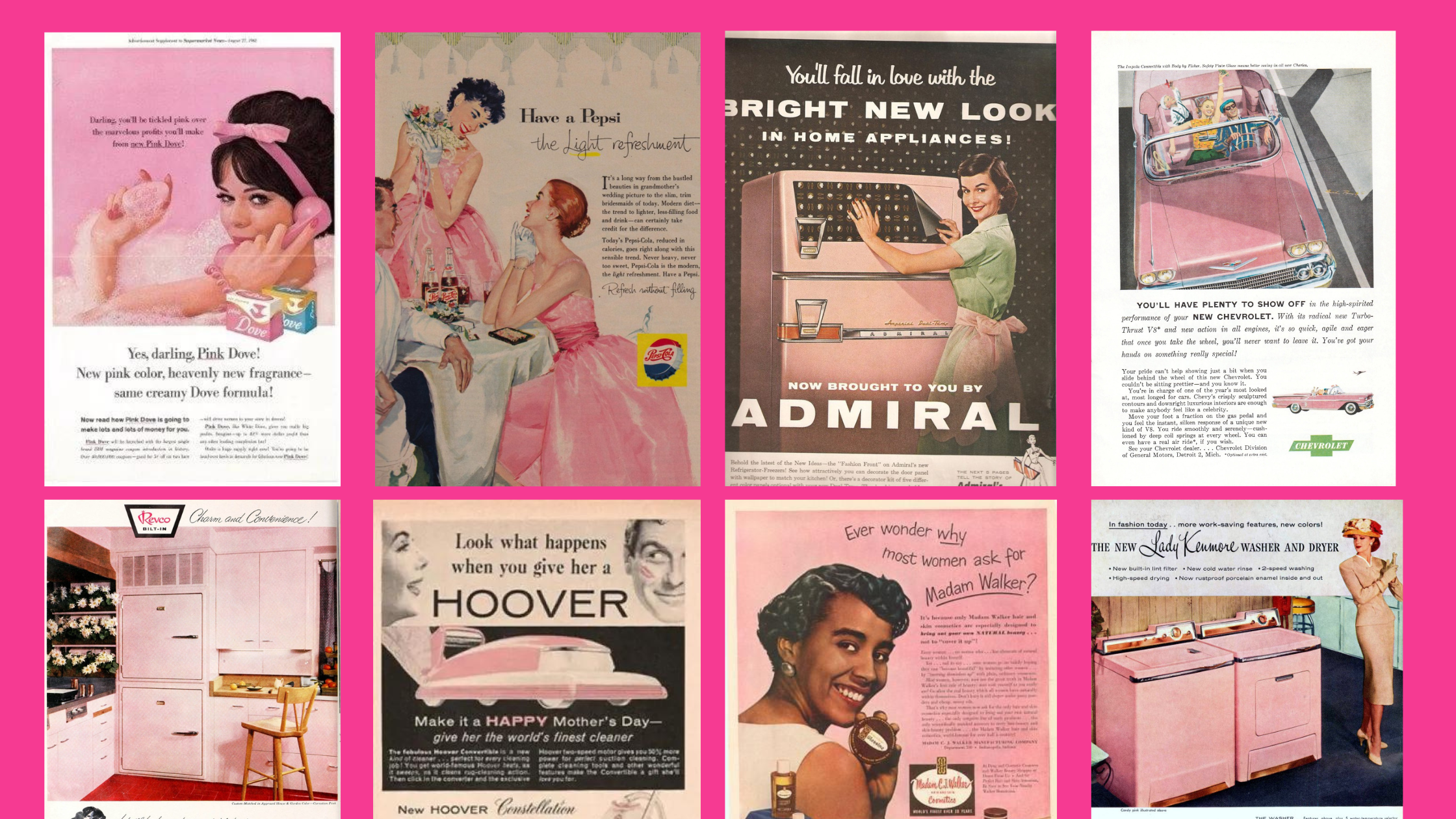
Remember, Barbie® was released around this time.
Barbie®'s creator, Ruth Handler, observed that most dolls on the market at the time were baby dolls and there was a lack of dolls that allowed children to imagine themselves as older and independent individuals.
Isn't that interesting? A push for women to "get back to home" while men "get back to work" - and then a personification of this "perfect woman" in an adult doll.
Pink, in a way, tied women to being within a certain role and looking a certain way.
Flash forward to Barbieland® in the movie, where Gerwig coined artificial authenticity.
Is it that far from the truth?
Culture, history and gender roles are just of the few components to truly understanding the power of a color. We can see here that there are many factors at play when it comes to how Barbie® and the color pink itself have transformed culture since its release and skyrocketing success - culminating in the movie.
The movie, where women worldwide felt seen, empowered and outright joyful.
Let's dig deeper.
The first is gender norms and stereotypes. The color pink, often linked to femininity, has sparked conversations about how societal expectations influence the way we perceive and define gender roles.
The movie itself does this! Their own tagline, "She is everything, Ken is just Ken," sets us up for challenging society's normal thoughts on who the female character is in relation to its male counterpart. In this movie, Ken is the accessory; he is the secondary character put there to look pretty and only supports Barbie when and how she needs. This is the opposite of how most male characters are written in films throughout history, where women are usually the accessories or secondary heroes.
It also has highlighted empowerment and diversity.
Barbie®'s evolution has seen efforts to promote diversity and empowerment in a variety of ways in the past decade.
The inclusion of dolls with different skin tones and professions challenges traditional beauty ideals and encourages inclusivity, reflecting changing cultural attitudes.
Barbie®'s portrayal of an unrealistic body shape has also raised concerns about body image and beauty standards, as well, which they combated by introducing Barbies of all different body shapes and heights! (Note: This did account for a 2 billion dollar revenue decrease during those releases - so is the world really ready to embrace more realistic versions when it comes to "artificial authenticity"?)
This has led to discussions about the influence of media, including toys like Barbie®, on individuals' self-perception and self-worth.
Barbie® even extends to consumer culture and marketing.
The color pink is not only associated with Barbie® but is used by various brands to market products to a female audience, contributing to discussions about commercialization and consumerism...What can bond people together for a cause, for a movie, for an idea, and how can one color be used to do it?
Pink, as represented by Barbie®, can also symbolize empowerment and play.
Many argue that playing with dolls like Barbie® can encourage imaginative thinking, creativity, and storytelling, which are essential for cognitive development.
It's important to note that while Barbie® and the color pink have had a significant impact on culture, these effects are complex and multifaceted.
They have sparked debates, conversations, and changes in societal attitudes, highlighting the interconnectedness of consumer products, media representation, and cultural values.
Why Did People Love The Movie So Much?
When I polled my audience to see what they thought of the movie, I mainly got responses from women aged 20-50.
Here are some of the responses I received:
"It brought me joy."
"I felt uncomfortable, emotional (cried), humor (laughed), annoyed, confused, nostalgic. It was an emotional rollercoaster."
"It was fun. It made me feel nostalgic, playful, and powerful."
"Seen. It was funny, empowering and inspiring but most of all it made me feel seen."
This surprised me. I could understand fun, joy, nostalgic...but seen? Empowered?
How could this possibly be true? A brand that Aqua perfectly describes as "life is plastic - it's fantastic" makes women, once girls who owned the dolls, feel empowered?
That's what's so powerfully interesting about Barbiecore®. Perhaps the most powerful visual link between a brand and its color in history. Where people show their allegiance to a brand by wearing its color.
Where people, in this case mainly women, actually feel empowered by wearing it.
This is what I can't get over. The power of a color and how it can bring people together or tear them apart.
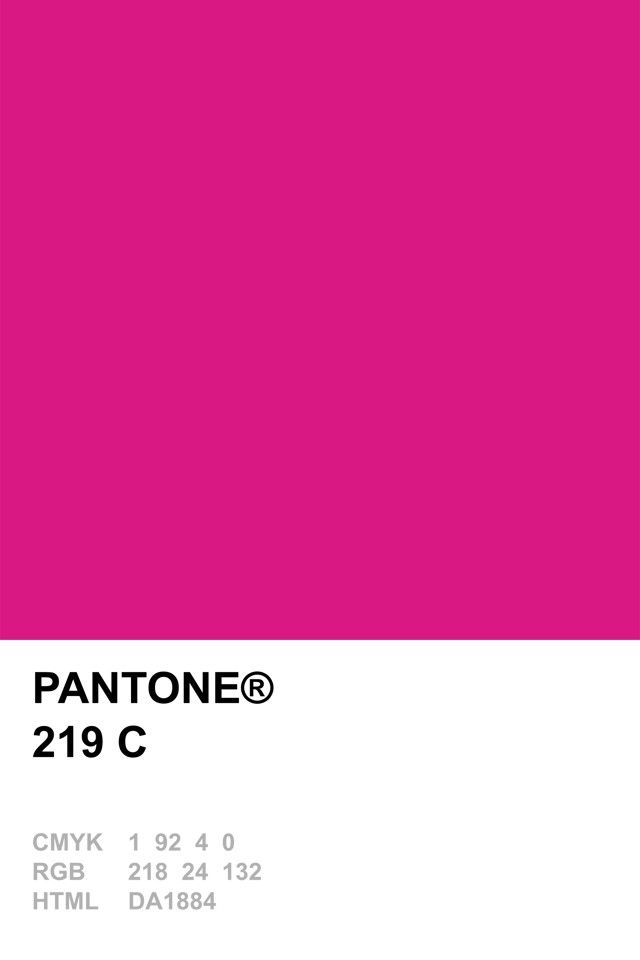
This remarkable transformation can be credited to the brilliance of the Barbie® marketing campaign.
From television commercials to print advertisements, Barbie®'s creators consistently emphasized the allure of her dream-like world, which resonated with children's fantasies.
"Pink is not just a color; it's a statement. It's a color that demands attention and carries a message of joy, love, and acceptance. When used correctly, it can profoundly impact consumer behavior and brand loyalty." (Color Secrets, Michelle Lewis)
Conclusion

The Barbie® movie encapsulates the power of nostalgia, history, culture and color psychology. The epitome of how successfully a brand can become if it thinks completely and emotionally through a marketing campaign.
Barbie®'s marketing campaign stands as a testament to the power of color psychology and its ability to shape perceptions, influence emotions and create cultural phenomena. And it proves that color is key to creativity, connection, conversion and a lasting emotional memory.
There are few things as powerful as color - and in this case, the color pink!
The strategic use of pink, along with a brilliant marketing strategy, has not only made Barbie® an enduring icon but has also inspired a broader shift in breaking gender stereotypes and empowering children to dream big.
Through emotional connections, nostalgia, limited editions, influencer marketing and engaging experiences, Barbie® has sparked a frenzy that continues to captivate the hearts of both young and adult fans, solidifying its position as a cultural icon and maintaining its enduring popularity.
So the next time you see that iconic shade of pink, remember the revolution it sparked in the world of toys, movies and lasting color memories.
Stay Color-Connected.
Join our private email community where you'll be the first to know about new articles, color tips + even more secrets about color psychology! 🌈
We don't spam. Mainly because Michelle doesn't eat pork.
















